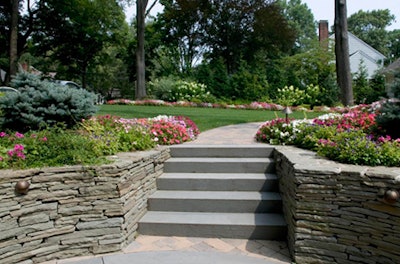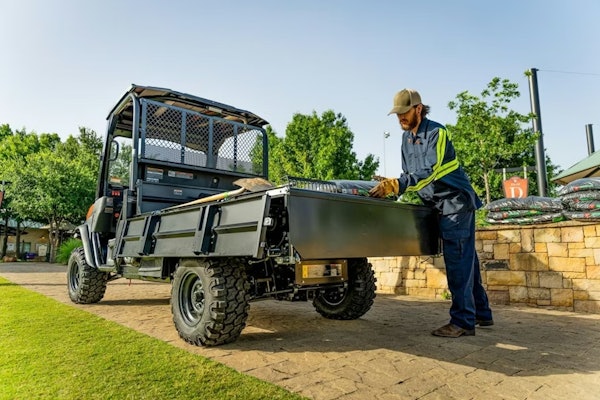
 Designed and built by Borsh Landscape & Design
Designed and built by Borsh Landscape & DesignWhether a site contains steep slopes or gentle ones, retaining walls have the potential to create level space for outdoor living, play and planting beds. They also offer the opportunity to introduce a pleasing design element and material to the landscape and generate visual interest through elevation changes.
Paul Fredell, president of landscape design and installation company Fredell Enterprises, Colorado Springs, Colorado, notes that in addition to their functional duties, retaining walls can create ambiance. The key to building a retaining wall that will improve the overall look of a landscape is choosing a wall material that works well with the home and landscape. Jody Shilan, owner of Jody Shilan Designs, Wyckoff, New Jersey, says many homeowners and contractors fail to do this.
“They’re very happy with the way the spaces feel,” says Shilan. “They’re excited to come home each day and see what’s been done.”
The following project profiles could give you some ideas for your next retaining wall job.
Creating multi-functional areas
Starting point: After demolishing a 1950s-era house on a corner lot, the property owners set out to build a larger, dream home (a common practice in their area of New Jersey). The new house would be positioned at an odd angle on the lot in order to comply with setback requirements, rendering front, back and side yards indefinable. The clients requested a level play area for their 6-year-old twins. The sloped grade under the original driveway, which was removed with the old house, made playing sports such as basketball impossible since the ball would bounce or roll away as soon as it hit the ground. In front, the grade sloped up toward the site of the tall, colonial-style, new home.
The plan: The homeowners began working with Shilan to develop hardscape spaces as soon as they established building plans for the house. Retaining walls were a given, so Shilan helped the couple choose stone for the home’s foundation, entrance and chimney that could be matched to a wall stone. To create a large, level space where the clients’ children could play and ride bikes without going in the street, Shilan changed the grade of the driveway area, building up one side and cutting into the other. He designed a 2-foot-high, 35-foot-long, L-shape wall to hold back the slope around the driveway. The dry-laid granite wall doubles as seating space for the children when they need to “take a breather” while playing basketball and for the parents when they watch their children play. The driveway also is big enough for three or four cars.
“I’m big on seat walls in combination with the retaining function,” Shilan says. “Everything I design, I try to have at least two uses for it.”
Another 2-foot-high, 30-foot-long wall retains a slope next to a walkway. The clients had the choice of a long, sloped front walkway or a modified level yard held in place by retaining walls. They opted for the latter, and Shilan designed two, 20-foot-long, 2-foot-high walls with steps for the walkway built into them. The walls define the front yard and the grade change “creates visual interest and gives formality to the front of the house,” Shilan says.
Challenges: The granite was difficult to chip and manipulate into the necessary shapes. But for this project, granite was the only stone that would work, and the results were worth the extra effort, Shilan says. “The walls look like a continuation of the house,” he says.
Outcome: The family recently moved into the home, and the retaining walls are part of the first landscaping phase. “They’re ecstatic about it,” Shilan says of his clients. “They’re very happy with the way the spaces feel. They’re excited to come home each day and see what’s been done.”
Price tag: $20,000 for walls
Construction period: Two and a half weeks
Carving out usable space
Starting point: In order to construct a home on a 5-acre, hillside lot in Colorado, a considerable amount of soil had to be retained. In addition, the homeowners wanted flat outdoor living spaces, including a children’s play area level with a second-floor walk-out, a patio and planting areas. A 15-percent slope toward the house created a drainage obstacle.
The plan: Fredell determined retaining walls that would divert runoff and create usable space were key to meeting the homeowners’ goals. The clients chose a neutral brown/gray blend of ledge stone similar to the rock on their home, and crews dry-laid the stone, which varied from 3 to 8 inches thick, 1 to 3 feet long, and bedding depth up to 2 feet. Fredell employees handpicked only premium stones for the project. A 175-foot-long retaining wall surrounds the back of the house. A series of walls in front create terraces for planting and allows for level patio and play spaces. A stream-like water feature – the mutual idea of the homeowners and Fredell – runs through these walls, falling 8 feet over a 16-foot run. So the clients could observe exactly where the water feature would be, workers first built the walls then disassembled them. They constructed the stream bed before reassembling the walls. Crews constructed some walls while the house was being built. Retaining walls were necessary before the homebuilder could pour the patio or construct the garage area, for instance.
Challenges: About three years ago, inspectors in the area began enforcing the 2-to-1 slope ratio and 4-foot maximum wall height required by code for projects without engineering, Fredell says. Before, 1-to-1 ratios were acceptable. Due to the region’s steep terrain, meeting the code is difficult and was particularly challenging with this project. Soils at the site ranged from sandstone to clay, so workers installed crushed-gravel footers up to 2 feet thick and compacted them with plate tampers to ensure stability. “Basically, we dug a ditch at the base of the walls,” Fredell says. When workers began digging into the hillside behind the house to construct the long wall there, water began seeping out of the soil. To overcome this problem, Fredell backfilled the wall with pea gravel, which allows water to seep into a collection area at the wall base, where a drainage system carries it away from the house and yard.
Outcome: “The clients were extremely happy with the uniformity of the walls because they tie directly in with the stone on the home,” Fredell says. “They love the way the water feature looks so natural coming down through the walls.”
Price tag: Approximately $40,000
Construction period: Four months, with work taking place intermittently due to home construction and winter weather.
Connecting outdoor and indoor living spaces
Starting point: The homeowners wanted to expand their backyard’s outdoor living area. The space, which would include dining and sitting areas and a small outdoor kitchen, needed to connect seamlessly with the indoor kitchen and family room areas of the home. But the backyard’s grade was lower than the walk-out level of those rooms. An existing wood deck provided a level walkout, but a sunken spa in its center left no room for entertaining.
The plan: At the clients’ request, Terry McMahon and design coordinator Amie Armstrong of Borst Landscape and Design tried to preserve the deck in their original plans. But it kept cropping up as an obstacle to the overall goals of the project. So they came up with a design that would create a raised patio via a retaining wall and presented it to the homeowners. “They absolutely fell in love with it,” McMahon says. The 70-foot-long wall with a maximum height of 4 feet would be made of dry-laid colonial bluestone, and would create level space for a 450-square-foot patio. Two sets of Karney stone steps built into the wall would provide access to the backyard. McMahon designed 2-foot-wide planting beds between the top of the retaining wall and the patio. Under local code, these planting beds eliminate the need for a handrail. “It’s a great option,” McMahon says. “It softens the look of the patio.”
Challenges: The house is clad in red brick, a difficult material to match, McMahon says. Bluestone is McMahon’s No. 1 hardscaping material choice in conjunction with red brick. Even though bluestone provides more of a contrast than a complement, the colors “marry well” aesthetically, she says. The homeowners wanted to keep some shade trees close to the proposed location of the wall, so McMahon and Armstrong adjusted the patio plan by shortening one side and expanding the other, creating an asymmetrical shape that presented design and construction challenges. “We had to create that design so that it fulfilled all the space needs, along with access points, while not interfering with the yard,” McMahon says. Access from the driveway area, kitchen and family rooms was necessary in addition to the step exits into the backyard. The patio includes straight lines and semi-circular forms. Both sets of stairs enter semi-circular sections of the patio. “Inserting the linear steps into the curved patio was quite a challenge,” McMahon says. But the lines are tight and neat, she says, a testament to the exceptional craftsmanship of the crew, which Borst production managers oversaw.
Outcome: “They love the transformation,” McMahon says of the homeowners. “They were concerned about the brick, but the natural, colonial bluestone was ideal. Using the retaining wall and lifting the elevation allowed the space to relate to the house the way they needed it to. On the other side, the look is beautiful because of the stone.”
Price tag: $20,300 for retaining wall
Construction period: Seven weeks, including the construction of the patio, outdoor kitchen, walkway and a freestanding wall







